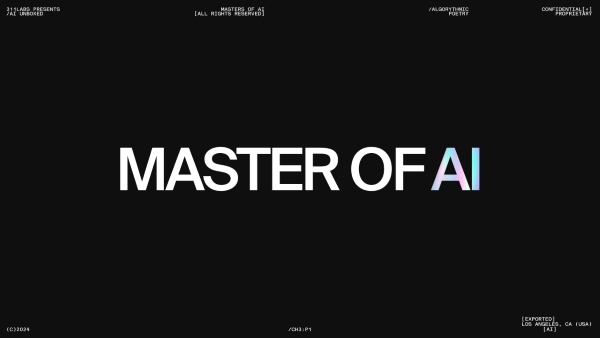[Group Buy] Masters AI for Creatives
$1,699.00 Original price was: $1,699.00.$99.00Current price is: $99.00.
- Delivery: You Will Receive A Receipt With Download Link Through Email.
- If you need more proof ofcourse, feel free to chat with me!

Description
Table of Contents
ToggleIn today’s rapidly evolving digital landscape, the term Masters AI for creatives has taken on a new significance. As artists, designers, musicians, and writers increasingly integrate artificial intelligence into their workflows, the boundaries of creativity are expanding beyond human imagination. The intersection of AI and creative industries is not just a trend; it’s a transformative movement that challenges traditional concepts of art and creation.
Introduction to AI in Creative Industries
As we delve into the fascinating world of artificial intelligence in creative sectors, it becomes essential to understand what AI truly represents.
Understanding Artificial Intelligence
Artificial Intelligence (AI) refers to machine systems designed to perform tasks that typically require human intelligence. These tasks can include problem-solving, learning, reasoning, and understanding natural language among others. While AI was initially rooted in strict algorithms and rule-based systems, recent advancements have propelled us into an era of machine learning, where computers learn from vast datasets, improving their performance over time without explicit programming.

From predictive text in our smartphones to recommendation engines on streaming platforms, AI’s capabilities are far-reaching. Its integration into creative domains signifies a monumental shift—one where technology does not replace human creativity but augments it. This relationship is crucial for professionals in creative fields who wish to embrace innovation while retaining their artistic expression.
The Role of AI in Modern Creativity
The role of AI in modern creativity is multifaceted. AI serves not only as a tool for enhancing productivity but also as a collaborator—stimulating ideas and exploring possibilities that may not be immediately apparent to human creators. Whether through generating visual art, composing music, or assisting in writing, AI technologies are redefining how we approach creative projects.
As creatives adopt these tools, the potential for experimentation increases exponentially. This amalgamation of man and machine heralds a new era of artistic expression, where innovative ideas flourish, and boundaries are pushed. It creates an environment where artists can focus more on conceptualizing and less on the mundane aspects of execution, nurturing a culture of exploration and originality.
Benefits of AI for Creatives
Harnessing AI’s potential offers numerous benefits for creatives across various industries. By understanding these advantages, artists can cultivate more effective practices and enhance their work quality.
Enhancing Efficiency and Productivity
One of the most immediate benefits of integrating AI into creative processes is the enhancement of efficiency and productivity. Repetitive tasks such as photo editing, video rendering, and even basic content generation can be automated, allowing creatives to dedicate their time to more meaningful work.
For instance, graphic designers have access to AI-powered design tools that generate color schemes, layouts, or even entire compositions based on user inputs. This automation not only speeds up the workflow but also encourages faster iterations of designs.
Moreover, AI algorithms can analyze vast amounts of data to identify trends and preferences within moments, enabling marketers and content creators to tailor their outputs to their audiences efficiently. This level of analysis would take humans considerably longer, showcasing how AI can optimize creative work by providing actionable insights quickly.
Unlocking New Creative Possibilities
Beyond mere efficiency, AI empowers creatives to explore uncharted territories within their disciplines. In literature, AI tools can assist authors by suggesting plot twists, character development arcs, or even generating entire chapters based on established themes.
In the realm of visual arts, we see AI systems producing artwork that challenges conventional aesthetics, pushing the envelope of what we consider ‘art.’ Artists like Mario Klingemann utilize neural networks to produce astonishing pieces that fuse human creativity with algorithmic precision. Such collaborations open doors to possibilities previously constrained by human imagination alone.
With AI’s ability to analyze countless styles and techniques, creators can draw inspiration from various sources, enriching their work and expanding their creative horizons. This interplay between human vision and AI-generated output fosters a dynamic, ever-evolving creative landscape.
Personalization and User Experience Improvement
AI excels in personalization—a crucial factor in today’s creative industries. Artists can leverage AI’s capability to analyze user behavior and preferences to tailor experiences that resonate deeply with audiences. For instance, streaming services employ AI-driven algorithms to curate playlists that cater to individual tastes, enhancing user engagement.
By embracing AI, creatives can offer personalized experiences that elevate consumer interaction. In advertising, tailored campaigns driven by audience insights improve conversion rates significantly, creating a win-win scenario for both brands and consumers.
Furthermore, AI can facilitate feedback loops for creatives, allowing them to adjust their work based on real-time responses from their audience. This iterative process not only enriches the creative experience but also builds stronger connections between artists and their audiences.
Exploring Different Types of AI Technologies
To fully grasp the potential of AI in creative industries, it’s vital to explore the different types of AI technologies available and their applications.
Machine Learning and Its Applications
Machine learning represents a subset of AI that enables systems to learn from data and improve automatically through experience. For creatives, this means harnessing algorithms capable of analyzing patterns and predicting outcomes.
In graphic design, machine learning can analyze thousands of existing designs to suggest visually appealing combinations based on user input. For content creators, AI can scrutinize audience engagement metrics to recommend topics predicted to resonate with target demographics.
Additionally, machine learning algorithms are used extensively in recommendation systems, dictating what content users are likely to engage with next. This technology enhances the user experience in creative industries, ensuring that audiences remain engaged and connected with relevant material.
Natural Language Processing for Content Creation
Natural Language Processing (NLP), another critical branch of AI, focuses on the interaction between computers and humans using natural language. In the context of content creation, NLP tools can aid in drafting articles, generating marketing copy, and even enhancing storytelling techniques.
Writers can effectively use NLP tools to brainstorm ideas, organize thoughts, and refine drafts. Moreover, AI-driven content suggestion systems can analyze reader preferences, offering insights on trending topics and optimizing content for SEO. This functionality allows writers to create engaging materials that evolve alongside public interests and behaviors.
With NLP, the ability to translate languages and generate subtitles opens up global opportunities for creatives, facilitating collaboration and sharing across borders. The application of AI in linguistic contexts highlights how technology amplifies communication, fostering richer interactions in creative endeavors.
Image Generation and Recognition Technologies
Image generation and recognition technologies powered by AI are revolutionizing the visual arts. Generative Adversarial Networks (GANs), for example, can create entirely new images based on learned parameters from existing ones. Artists can experiment with these technologies to produce unique works that defy traditional artistic conventions.
On the other hand, image recognition technologies enable creatives to streamline their workflows by automating processes like tagging, categorizing, and even selecting photographs. This eliminates tedious manual sorting, freeing artists to focus on their creative vision.
AI has also made significant strides in fashion, where image recognition helps brands track trends and consumer preferences. By assessing social media imagery and user-generated content, fashion designers can adapt their collections to reflect contemporary styles and needs.
AI Tools for Creatives
With the growth of AI technology comes an array of tools specifically designed for creative professionals. Understanding these options is essential for anyone aiming to utilize AI effectively in their work.
Overview of Popular AI Creative Tools
Several AI tools have gained traction in creative communities, each catering to different functions within the creative process. Products like Adobe Sensei enhance design workflows by incorporating intelligent features that simplify complex tasks, making them accessible to beginners and professionals alike.
Content creation platforms such as Jasper AI leverage advanced algorithms to generate written material, helping marketers and bloggers produce high-quality content quickly. Similarly, tools such as Runway ML allow artists to experiment with various media formats, utilizing machine learning to create innovative projects effortlessly.
These diverse applications demonstrate AI’s versatility, providing creatives with powerful resources to enhance their craft and streamline their processes.
Comparison of AI Software Solutions
When choosing the right AI tool, it’s important to consider their specific functionalities and how they align with your creative goals. Some solutions excel at generating visual art, while others focus on music production or text generation.
For example, Daz 3D specializes in 3D model creation, enabling animators to bring characters to life with ease, while AIVA (Artificial Intelligence Virtual Artist) composes unique musical scores based on genre specifications. Each tool has distinctive strengths and weaknesses, influencing how effectively they can be integrated into a creative workflow.
Evaluating software compatibility with existing tools is also essential. Many creatives rely on established software suites like Adobe Creative Cloud. Hence, finding AI solutions that seamlessly integrate with these systems can enhance usability and streamline project management.
Choosing the Right Tool for Your Creative Needs
Selecting the best AI tool hinges on understanding your specific requirements as a creative professional. Are you focused on visual design, content generation, or perhaps music composition? Identifying your primary objectives will guide you in narrowing down your options.
Once you’ve identified your needs, experimenting with trial versions of various tools can provide insights into their usability and effectiveness. Engaging with online communities or forums can also yield valuable recommendations from fellow creatives who share similar aspirations.
Ultimately, the right AI tool should amplify your creative process, allowing you to transcend limitations and explore new avenues of expression.
Case Studies: Successful Use of AI in Creative Projects
Real-world examples of successful AI integration into creative projects illustrate the profound impact of this technology on artistic endeavors.
AI in Visual Arts: Notable Examples
One of the most groundbreaking instances of AI in visual arts is the project “Edmond de Belamy,” created by the Paris-based art collective Obvious. Using GANs, the team produced a portrait that sold at auction for a staggering sum, instantly igniting debates around the nature of authorship in art. This project demonstrates how AI can challenge perceptions of creativity and ownership within the art world.
Another intriguing case is the collaboration between artist Refik Anadol and AI algorithms to create immersive installations. By harnessing data, Anadol transforms information into stunning visual experiences that captivate audiences, exemplifying the limitless potential of AI when paired with human artistry.
Innovative Applications in Film and Animation
In film production, AI is transforming the way filmmakers approach storytelling. Tools like ScriptBook analyze scripts for success predictors, offering insights into potential box office performance before filming begins. Such tools empower producers to make informed decisions about project viability, reducing financial risk.
Animation studios like Pixar and Disney are employing AI-driven software for facial animation and voice modulation, allowing characters to express themselves more authentically. This technology elevates storytelling by imbuing animated figures with nuanced emotions, resonating with audiences on deeper levels.
AI’s Impact on Music Production
Music production has also experienced significant disruptions due to AI integration. Platforms like Amper Music allow users to generate original soundtracks in seconds, catering to filmmakers and content creators in search of royalty-free music.
Major artists have begun collaborating with AI in their songwriting processes. The Grammy-winning artist Taryn Southern released an album co-created with Amper Music, showcasing how technology can serve as both a partner and a tool in the creative process.
Such partnerships highlight the evolving relationship between artists and AI, paving the way for deeper explorations of creativity within music production.
Ethical Considerations of AI in Creative Work
While AI offers immense potential for creativity, ethical considerations must not be overlooked. Addressing these issues is vital to create a responsible framework for AI’s role in the creative sector.
Copyright and Intellectual Property Issues
As AI-generated content becomes more prevalent, questions surrounding copyright and intellectual property are emerging. Who owns the rights to a piece created by an AI? Is it the programmer, the user, or the AI itself? These questions present complex legal challenges that need clarification as AI continues to permeate creative industries.
Establishing clear guidelines regarding ownership and attribution will be crucial in protecting the rights of all parties involved, particularly human creators who collaborate with AI technologies.
Bias and Representation in AI Models
AI systems are only as good as the data they are trained on. If biases exist within training datasets, these can perpetuate harmful stereotypes or marginalize certain groups in creative expressions. Ensuring diverse representation is critical, especially in areas like entertainment where narratives shape cultural perceptions.
Addressing bias in AI models requires ongoing examination and refinement of datasets to promote inclusivity. Collaboration between technologists and creatives can foster the development of more equitable AI solutions, ensuring that the stories being told resonate with diverse audiences.
The Human Element in AI-Created Works
As AI takes on more creative roles, it raises questions about the significance of the human touch in art. While AI can generate impressive outputs, many argue that the emotional depth and personal connection in human-created art cannot be replicated by machines.
The value of human creativity lies in its imperfections, reflections of lived experiences, and emotional resonances that AI cannot fully comprehend. Striking a balance between leveraging AI’s capabilities and honoring the essence of human creativity is essential for preserving the soul of artistic expression.
Future Trends in AI for Creatives
Looking ahead, the trajectory of AI in creative industries suggests a promising future filled with innovative possibilities.
Anticipated Developments in AI Technology
The rapid pace of technological advancement indicates that we will continue to see remarkable developments in AI capabilities. Improvements in natural language processing will likely lead to even more sophisticated tools for writers and content creators, streamlining the creative process further.
Visual arts can expect more refined generative algorithms that produce higher quality results while allowing for greater customization. As deep learning models evolve, they will become better equipped to understand and predict trends, aiding creatives in crafting relevant, engaging work.
Evolving Roles of Creatives in an AI-Driven Landscape
As AI becomes more integrated into creative workflows, the roles of creatives will inevitably change. Artists, designers, and musicians will transition from traditional creators to curators and collaborators, guiding AI systems to generate outcomes aligned with their visions.
Creatives will learn to harness AI as a supportive partner rather than a replacement, leading to new forms of artistic expression that blend human intuition with algorithmic power.
Preparing for the Future: Skills Development
Adapting to this evolving landscape necessitates continuous skills development. Creatives must familiarize themselves with AI technologies and understand how to leverage these tools effectively within their practice.
Engaging in educational programs that focus on the intersection of AI and creativity can provide invaluable insights. Offers of AI courses for professionals and beginners are now widely available, focusing on practical skills and real-world applications. These courses cover essential topics such as machine learning, deep learning, computer vision, and natural language processing, ensuring that learners build a strong foundation in AI.
With access to expert instructors and a supportive community, aspiring creatives can develop competencies that position them favorably within the industry. Completing projects and assignments solidifies learning and provides tangible evidence of expertise through certificates upon course completion.
Building a Career with AI as a Creative Professional
Navigating the evolving landscape of creative professions in the age of AI requires strategic planning and skill-building.
Essential Skills for the Next Generation of Creatives
To thrive in an AI-driven environment, creatives must cultivate a diverse skill set that encompasses both traditional craft and technological literacy. Familiarity with AI tools and an understanding of how to incorporate them into artistic processes are becoming increasingly essential.
Additionally, skills in data analysis and interpretation can empower creatives to make informed decisions based on audience insights, ensuring their work resonates with target demographics. Embracing interdisciplinary knowledge will enrich creative practices and set individuals apart in a competitive landscape.
Networking and Collaboration Opportunities
Building a successful career in an AI-influenced creative environment relies heavily on networking and collaboration. Engaging with like-minded professionals, attending industry events, and participating in online forums can spark new ideas and foster partnerships that drive innovation.
Collaborating with technologists and data scientists can lead to exciting projects that blend art and technology. The synergy between different skill sets promotes creative exploration and expands the possibilities of what can be achieved together.
Continuing Education and Lifelong Learning
In an era where technology evolves rapidly, embracing lifelong learning is vital. Creatives must remain curious and adaptable, continuously seeking opportunities to expand their knowledge and skills.
Investing time in workshops, online courses, and mentorship programs can empower creatives to stay ahead of trends and develop expertise in relevant AI applications. The commitment to ongoing education ensures that creatives remain agile and well-prepared for the changing dynamics of their industries.
Conclusion
As we navigate the intersection of technology and artistry, the concept of Masters AI for creatives emerges as a guiding principle for the future of creative work. By embracing AI, creatives unlock unprecedented opportunities for innovation, collaboration, and growth.
Though the journey presents challenges—ethical dilemmas, evolving skill sets, and shifting roles—the potential for transformation is immense. The partnership between human creativity and AI technology promises to reshape the landscape of art, design, music, and storytelling, propelling us into a new era where imagination knows no bounds.
In this brave new world, creatives who master AI will find themselves at the forefront of a revolution, equipped to inspire, innovate, and connect with audiences on deeper levels than ever before. The future of creativity is here, and it is intertwined with the power of artificial intelligence.
Sales Page:_https://www.mastersofai.courses/
Delivery time: 12 -24hrs after paid
Related products
-
Sale!

[GroupBuy] Coach Kyle – Confidence and Self Mastery [November 2024]
$125.00Original price was: $125.00.$72.00Current price is: $72.00. -
Sale!

[SCAM or Legit] Adam Lucero – Superhuman Discipline System
$497.00Original price was: $497.00.$25.00Current price is: $25.00. -
Sale!

Jesper Nissen – Advanced Cloudstack For SEO Course
$197.00Original price was: $197.00.$24.50Current price is: $24.50. -
Sale!

Robby Blanchard Commission Hero AI
$997.00Original price was: $997.00.$39.00Current price is: $39.00.

Reviews
There are no reviews yet.